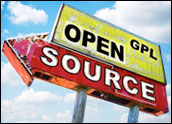
Note to those avoiding Linux: Yes, you can do desktop publishing. You cando it with Scribus.
One of the most frequently recurring comments I hear about why somebody — especially in a small-business environment — will not migrate toLinux is the alleged absence of a desktop publishing (DTP)application. I think this is one of the most under-reported aspects inusing Linux instead of Microsoft Windows or Mac computers.
Let’s be clear here: Windows-based commercial-strength page design andillustration programs far outnumber what you will find for Linuxdistros. Some of the Windows-based DTP programs you won’t find inLinux are Adobe’s Quark Express or Pagemaker, Microsoft Publisher andBroderbund’s Print Shop. These and numerous other programs are inpopular demand by consumers looking to make brochures, posters andgreeting cards.
What you will find for Linux, though with much fewer choices, aresolid contenders for doing these same tasks, whether for business orpersonal use. For instance, Grasshopper’s Pagestream is a multi-platform DTP program thatsells for US$99. Oftentimes, a specialty DTP app is just a luxury. Thesame DTP tasks are handily done with full-powered word-processingsuites such as OpenOffice Writer.
Perhaps the most well-known page design app for Linux isopen source Scribus. This is aprofessional-strength page layout application with a user-friendly interface.Scribus has essential publishing features such as CMYK color,separations, Spot Colors, ICC color management and versatile PDFcreation.
Not the Same
Using page design apps such as Scribus is not the same as using wordprocessors like Open Office Writer or AbiWord (See my review here. Witha word processor, you directly type text onto a blank page and insertgraphics elements such as photos and graphs into the word flow.Wrapping text around the graphics and setting font and column sizesare done by adjusting settings that are usually a right click ordrop-down menu away.
That is not the case with DTP apps. The interface is different. Thatoften generates criticism from new users that Scribus is confusing touse. Do not fault Scribus for an interface standard that is endemic toDTP apps in general. It is not Scribus or Linux. It is the way pagedesign programs on any platform work. Once you approach Scribus withthat mindset, the logic behind using Scribus falls intoplace.
Before you can add text to a page, you must first create a text box.Then you can create text live by typing it into the box or using thecopy and paste function from a text file. You make headlines andcaptions the same way.
Quirky Interface
Before migrating to Linux, I was a frequent user of MicrosoftPublisher, Print Shop and Pagemaker. So I expected that working my waythrough Scribus would be old hat instantly. It did not completely workout that way.
DTP programs and learning curves go hand in hand. The concept issimilar as you move from app to app, but the process of putting thepage elements in place can vary. They vary unexpectedly in some areaswithin Scribus.
Not All Bad
Scribus taps into features found in other open source apps. Forinstance, it is easy to load documents created from the OpenOffice.orgsuite — Writer, Spreadsheet and Presenter. This cuts down ondesigning pages for new projects from scratch if preliminary materialsare already available.
To do this, click on the Page menu and then select Import. This opensa dialog box to point to the file location. The next line in this boxallows a number for how many pages to insert from this document. Afinal line lets you choose whether to insert the pages before, afteror at the end of the current location.
Another piggyback feature in Scribus uses GIMP (GNU Image Manipulation Program) to edit graphics placedon a Scribus page design. See my review of GIMP here. Selecting the editimage option after right-clicking on a photo or other graphic loadsthe item into GIMP. When finished editing, save the image in GIMP andexit. Then right-click on the image on the Scribus page and select theUpdate image option to refresh the page.
Powerful Menu Options
Any doubts that Scribus lacks professional-strength features aredispelled by browsing through its menus. Clearly, Scribus does plentyof business publishing tasks, such as creating stationery, fliers andbrochures. It handles color separations and color management for PDFfiles and other page formats to send to commercial printers.
For example, the Item menu includes controls for locking/unlockingimage attributes, PDF options and photo levels. The Insert menu hasoptions for tables, shape, polygon, line, Bezier cure and Freehandline.
The Character options under the Insert menu show careful attention topublishing needs. These choices include the application of smarthyphen, non-breaking dash, bullets, middle dot, em and en dashes andquotation dash. Similar options exist for quote mark variations, spaceand breaks as well as ligature.
Fully Functional App
Scribus provides features that typically are not found in most otherpage-design products. For example, the Extras menu lets you manageimages, hyphenate and dehyphenate text under certain conditions,generate a table of contents and create a barcode.
The Script menu has nearly one dozen font, text and color options toapply to a page design on its Scribus Scripts sub-menu. Also, aScript console is built in.
Similarly, The Windows menu is loaded with a dozen more designoptions. The Style menu offers a range of features under font, size,effects, alignment, color, shade and tabulator choices.
More Needed
Much of the burden for page designing rests with the user. Scribuscould be enhanced if its development community provided more supportfor additional templates for a variety of publishing projects.
The included set offers a brochure, newsletter, presentation andtext-based designs. Free third-party templates are available onlinefor those who spend some time looking for them.
Despite an interface anomaly here and there, Scribus is not challenging to learn. Its features includethe ability to lay down text and graphics frames, link text to flowfrom frame to frame, create outlines and design master pages forrepeating page elements and design grids.






















































